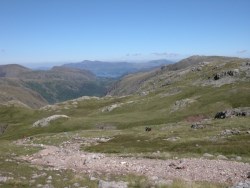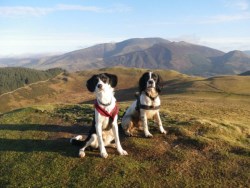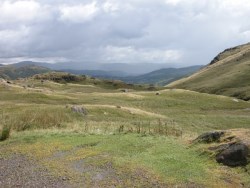The Cumbria Way
The Cumbria Way is a 70 mile walk through the Lake District which can be walked in 5 stages, each 11 to 15 miles long. It starts at Ulverston and continues through to Carlisle and takes in Coniston Water, Tarn Howes, Borrowdale, Derwent Water and Keswick. It is necessary to have a map as a guide for the walk as its not completely waymarked. A useful guide and most recent guide is The Cumbria Way by Paddy Dillon
The Cumbria Coastal Way
There are excellent public transport links with the Cumbria Coastal Path so it is quite possible to walk just one of its sections, rather than attempting the whole 192 miles. As the maximum height above sea level is only around 100 metres it is a fairly easy walk, and therefore would suit people of all ages and abilities. The complete route is usually walked in around 10 to 14 days. The walk starts at Silverdale on Morecambe Bay, and traverses along the Cumbria coast through the Lake District National Park to Solway Firth and ends at Gretna in Scotland. There are various places to stay along the route.
If you do get lost or have an accident whilst out walking you should call the Mountain Rescue Service by dialling 999.
If you intend to go off exploring then make sure someone knows where you are going (even if you can only give an approximate area that you are going to explore) and what time you expect to return. A form is provided on this site which you can complete and hand to a friend or hotel/guest house reception who can then alert Mountain Rescue should you not return as expected.
If you intend to go off exploring then make sure someone knows where you are going (even if you can only give an approximate area that you are going to explore) and what time you expect to return. A form is provided on this site which you can complete and hand to a friend or hotel/guest house reception who can then alert Mountain Rescue should you not return as expected.
Dogs do not normally need to be kept on the lead on a public right of way. However, if you are visiting the Copeland Council area (around Whitehaven and Egremont) Dog Control orders are in place in many areas which mean dogs have to be kept on leads. Check the council website for more information.
Wainwright’s Coast to Coast Walk
For a walk through the best of Northern England encompassing the three National Parks of the Lake District, Yorkshire Dales and North York Moors you can follow in Wainwright’s footsteps on the 192 mile coast to coast path. The walk starts at St Bees in Cumbria, and finishes at Robin Hoods Bay on the Yorkshire coast. Wainwright advised walkers should dip their feet into the Irish Sea at the start, and into the North Sea at the finish.
The walk can be completed in 12 stages each ends at a town or village where the walker can find accommodation for the night. Unlike the Cumbria Coastal Path this walk traverses many different terrains which includes climbing some fells, and some of the surfaces are rocky and steep.
If you have not taken your dog to the area before you may well find it best to use a lead as it may be a completely different environment, and new smells and different animals may distract and make even the best behaved dog forget his recall.
On Open Access land dogs must be kept on a lead no longer than 2 metres long between the 1st March and 31st July as this is the breeding season for ground nesting birds. You should also use a lead at all other times if you are walking near farm animals. If your dog worries livestock then the farmer is within his rights to shoot it.
Most walks will be suitable for dogs, but do check the likely conditions before you start out. The top of Scafell Pike, for example, may not be suitable for most dogs. Taking your dog on a walking holiday may mean things arise that you may not have expected. It can get very hot in the Lake District, and some fells have little shelter so be on the look out for symptoms of heat stroke. You should check your dog for ticks every day, and be aware that there may be adders about. Before you go on holiday make sure you know basic first aid so you know what to do if your dog is affected.
On Open Access land dogs must be kept on a lead no longer than 2 metres long between the 1st March and 31st July as this is the breeding season for ground nesting birds. You should also use a lead at all other times if you are walking near farm animals. If your dog worries livestock then the farmer is within his rights to shoot it.
Most walks will be suitable for dogs, but do check the likely conditions before you start out. The top of Scafell Pike, for example, may not be suitable for most dogs. Taking your dog on a walking holiday may mean things arise that you may not have expected. It can get very hot in the Lake District, and some fells have little shelter so be on the look out for symptoms of heat stroke. You should check your dog for ticks every day, and be aware that there may be adders about. Before you go on holiday make sure you know basic first aid so you know what to do if your dog is affected.

Join us on
Please visit the Sitemap to see the full range of information on this site
MountainWalk.co.uk is produced by Trish Haill Associates Copyright
Have you climbed Ben Nevis, Snowdon or Scafell Pike? Or taken part in the Three Peaks Challenge? Or have a special walk you'd like to share? We'd love to here from you! Join us on Facebook or Send us an email.
Walking in the Lake District
With 885 square miles to explore the Lake District National Park simply inspires walking. Even if you go for a family holiday you will find yourselves doing one or more walks as it’s simply the best way to get away from the crowds and enjoy the fantastic scenery. And it’s very likely that once you’ve started walking you’ll want to go further and the bug will have hit you.
Some people may want to conquer the Wainwrights - all 214 peaks, and this may be your goal when you visit the Lake District. Or for fitness or mobility reasons, or because you are travelling with young children in buggies you may want to stick to the gentle accessible paths. Whatever you want, you’ll find a route to suit your needs.
This page sets out to give some ideas of what you might want to consider. Many of the walks to places of interest will have car parking facilities.
Normally these will be run by the National Trust, so if you are going to be using a number of these parking places around the park joining the National Trust before your holiday could save you a lot of money.
This page sets out to give some ideas of what you might want to consider. Many of the walks to places of interest will have car parking facilities.
Normally these will be run by the National Trust, so if you are going to be using a number of these parking places around the park joining the National Trust before your holiday could save you a lot of money.

Open Access across the National Park.
As well as the miles of footpaths, bridleways and cycletracks, 55% (500 square miles) of the National Park is classified as Open Access land. You are able to walk anywhere across this land, but you are not allowed to cycle or ride a horse. It is also not permitted to camp or swim. A leaflet can be downloaded giving you more information about the open access areas and what you can do there.
Where can you walk in the Lake District?
Public Rights of Way
There are 1,913 miles of public right of way across the Lake District National Park. These mainly consist of footpaths, bridleways (which can be used by cyclists and horse riders) and permissive paths where the landowner has agreed that the public can cross the land. All rights of way should have a marker where the path leaves a road. The right of way only applies to the actual footpath - it does not give you the right to free roam off either side of it unless it is Open Access Land.
There are 1,913 miles of public right of way across the Lake District National Park. These mainly consist of footpaths, bridleways (which can be used by cyclists and horse riders) and permissive paths where the landowner has agreed that the public can cross the land. All rights of way should have a marker where the path leaves a road. The right of way only applies to the actual footpath - it does not give you the right to free roam off either side of it unless it is Open Access Land.
Land which is part of this scheme will be displaying this symbol.
General Advice on Walking
If you decide to go off the beaten track on the Open Access land, or if you climb one of the fells, be aware that there are many paths criss crossing the National Park and way markers or marker cairns may be difficult to spot or can easily be missed. Due to the mountainous terrain the weather can change quickly, and although you started out in sunshine you may find yourself suddenly in dense fog.

If you intend to do much walking then invest in a decent map and compass, and learn how to use if before you start off. There is a useful guide on how to use a map and compass here, and you may find it useful to read of one family’s experience when the weather turned. Having a map and compass and being properly equipped for walking is also advisable if you are planning to go anywhere other than the well marked easier footpaths.
The simple advice if you’ve never walked in the Lake District before is just get out and do it. Wherever you are staying you are bound to be close to the starting point of a lovely footpath of a walk to a beautiful waterfall or other feature may just be a short drive away. The local Tourist Information Centre will probably have free pamphlets outlining walks in the area. Unless you are going to be walking for hours or climbing one of the higher fells trainers or sturdy sandals will be suitable footwear. But when you want to undertake something more strenuous it is a good idea to invest in a pair of good walking boots.
Easy Lake District Walks
Lake District Walks for the Disabled or Limited Mobility
For those with limited mobility there are special ‘Miles without Stiles’ routes. There are currently 42 walks, many of which are suitable for assisted wheelchair users and pushchairs, and strong and confident wheelchair users may be able to complete all the routes. These routes are also suitable for those with older dogs, and the visually impaired. All the walks are described in full and can be downloaded from the Lake District National Park website.

Hugo and Oscar on Sale Fell - photo courtesy of Ruth Akers
Walking with Dogs in the Lake District
Dogs are welcome in the Lake District National Park as long as they (and their owners) are well behaved.
All dog mess should be picked up immediately and placed in one of the specially provided bins around the park. Don’t leave it for someone else to step in - and don’t bag it then throw it into the bushes as hanging black bags do not improve the scenery.
Dogs are welcome in the Lake District National Park as long as they (and their owners) are well behaved.
All dog mess should be picked up immediately and placed in one of the specially provided bins around the park. Don’t leave it for someone else to step in - and don’t bag it then throw it into the bushes as hanging black bags do not improve the scenery.
Short Lake District Walks
The main forests have a number of trails which are mainly between 1 and 3 miles in length. The forests are Whinlatter and Dodd Wood near Keswick, Grizedale Forest Park near Hawkshead and Ennerdale Forest on the western edge of the Lake District by the beautiful Ennerdale Water.
As well as the marked footpaths there is free access to most of the land within the National Park, but if you are going off the beaten track make sure you don’t wander too far or get lost.
Circular Walks
It is possible to walk round most of the lakes in the National Park, but some walks are not so well signposted. Some of the lakes you could consider are:
The main forests have a number of trails which are mainly between 1 and 3 miles in length. The forests are Whinlatter and Dodd Wood near Keswick, Grizedale Forest Park near Hawkshead and Ennerdale Forest on the western edge of the Lake District by the beautiful Ennerdale Water.
As well as the marked footpaths there is free access to most of the land within the National Park, but if you are going off the beaten track make sure you don’t wander too far or get lost.
Circular Walks
It is possible to walk round most of the lakes in the National Park, but some walks are not so well signposted. Some of the lakes you could consider are:
Easy Lake Walks
Tarn Howes - this is an excellent accessible path suitable for wheelchairs and pushchairs and is just 1.8 miles long.
Brothers Water - easy walk 2.5 miles in length
Loweswater - another fairly easy walk of 4.25 miles
Buttermere - fairly easy going on a well constructed path 4.5 miles
Blelham Tarn - this 4.5 mile walk can include a visit to Wray Castle (National Trust)
Coniston - again, fairly easy going and about 5 miles
Grasmere and Rydal Water - this is a popular walk of approximately 5.5 miles
Moderate Circular Lake Walks
Haweswater - this walk round the man made reservoir is 9 miles long
Derwent Water - 9.25 miles
Crummock Water - this walk is 11 miles long and is a moderate walk require a little climbing
Tarn Howes - this is an excellent accessible path suitable for wheelchairs and pushchairs and is just 1.8 miles long.
Brothers Water - easy walk 2.5 miles in length
Loweswater - another fairly easy walk of 4.25 miles
Buttermere - fairly easy going on a well constructed path 4.5 miles
Blelham Tarn - this 4.5 mile walk can include a visit to Wray Castle (National Trust)
Coniston - again, fairly easy going and about 5 miles
Grasmere and Rydal Water - this is a popular walk of approximately 5.5 miles
Moderate Circular Lake Walks
Haweswater - this walk round the man made reservoir is 9 miles long
Derwent Water - 9.25 miles
Crummock Water - this walk is 11 miles long and is a moderate walk require a little climbing
Circular Walk round Lake Windermere
The walk round Windermere, the largest lake in England is approximately 45 miles in length. The walk makes use of the shore paths at various points around the lake which are mainly accessible paths (suitable for all), so if you don't want to walk the whole way round you can take a stroll along part of the lake and back. The complete walk involves climbs at the higher points of the lake which give great views of the Lake District, Pennines and Morecambe Bay. On the eastern side of the lake access to the privately owned shoreline is limited, so the walk keeps as near to the lake as possible.
The walk round Windermere, the largest lake in England is approximately 45 miles in length. The walk makes use of the shore paths at various points around the lake which are mainly accessible paths (suitable for all), so if you don't want to walk the whole way round you can take a stroll along part of the lake and back. The complete walk involves climbs at the higher points of the lake which give great views of the Lake District, Pennines and Morecambe Bay. On the eastern side of the lake access to the privately owned shoreline is limited, so the walk keeps as near to the lake as possible.

The walk can be done in four stages - each of which can be completed in a day - with the start and end points coinciding with steamer, ferry and bus links so that it is possible to return to your accommodation in Windermere each evening.
The Wainwrights
When people talk of walking in the Lake District they often think first of the most famous walker, Alfred Wainwright. In his seven pictorial guides Wainwright describes the routes up 214 fells of the National Park, and 'Wainwright Bagging' is a challenge for many who try to follow in his footsteps. The walks vary widely in length and height, with Scafell Pike being the highest at 978 metres (3,209 ft). For more information on the Wainwrights see our other page.
Long Distance Walking Routes in the Lake District
Walking is the best way to see and appreciate the scenery, wildlife and flora of the Lake District National Park and surrounding areas so you may wish to spend all of your holiday following one of the long distance walks. There are campsites and hotels along the way, usually involving little more than a mie’s detour.
Many people look on these walks as ‘once in a lifetime’ experiences, whilst others, once completed, plan to start them all over again.
Whether you intend to walk all or part of these walks be aware that, although improving, the way is not always clearly marked and it’s best to have a map and/or guidebook available so you don’t end up miles out of your way.
Walking is the best way to see and appreciate the scenery, wildlife and flora of the Lake District National Park and surrounding areas so you may wish to spend all of your holiday following one of the long distance walks. There are campsites and hotels along the way, usually involving little more than a mie’s detour.
Many people look on these walks as ‘once in a lifetime’ experiences, whilst others, once completed, plan to start them all over again.
Whether you intend to walk all or part of these walks be aware that, although improving, the way is not always clearly marked and it’s best to have a map and/or guidebook available so you don’t end up miles out of your way.
Morecambe Bay Walk
The 8 or 9 mile walk across the sands of Morecambe Bay must be done only with an experienced guide. It is a very dangerous walk with areas of quicksand and some deep water to wade through, and channels to jump across. Cedric Robinson is the current official Queens Guide to take people across the sands. The walks normally take place between May and September and should be booked in advance.
The walks take up to four hours, and the recommended footwear is old trainers - although sand and sea might suggest walking in bare feet, the sand ridges can become painful.
The walks, which take place between May and September, are mainly to raise money for charity. They are extremely popular, and places need to be booked well in advance.
Do make sure you are fit enough to do this route - you can’t turn back half way!
If you are interested in joining a walk you should register via the relevant charity. Information on the walks for 2013 can be found on the Directory of Morecambe Bay Walks.
Walking Tour of the Lake District
This walk is 93 miles in length and is a circular walk starting and end at Windermere. Making good use of ancient paths used by shepherds and drovers the walk takes in the beauty of the Lake District passing through Coniston, Eskdale, Wasdale, Ennderdale Buttermere, Borrowdale, Grasmere and Ullswater before returning to the starting point via the Troutbeck valley. Accommodation can be found along the route.
Cistercian Way
The Cistercian Way is a 33 mile walk through South Lakeland. It started at the train station at Grange over Sands and continues to Carmel and it’s 12th century priory. From here it is advised to catch the train to Ulverston otherwise the walk continues over Carmel sands which should not be crossed without an expert guide. From Ulverston the walk continues to Dalton-in-Furness and then to Furness Abbey which was founded in 1124. The walk ends on Roa Island. The walk can be done in two or three days. The Cistercian Way is an ancient waymarked trail.
Other pages you might like:
Scafell Pike Walk
Scafell Pike from Wasdale
Scafell Pike Facts and History
Travelling to and Stay near Scafell Pike
Holidays in the Lake District
Foggy Scafell Pike
Dogs on Scafell Pike
The Wainwrights
Scafell Pike Walk
Scafell Pike from Wasdale
Scafell Pike Facts and History
Travelling to and Stay near Scafell Pike
Holidays in the Lake District
Foggy Scafell Pike
Dogs on Scafell Pike
The Wainwrights
Outdoor Activities in the Lake District
Windermere and the Southern Lakes
Kendal and District
Keswick and the North Lakes
Coast and Western Lakes
Penrith and the Eastern Lakes
Ulverston and South West Cumbria
